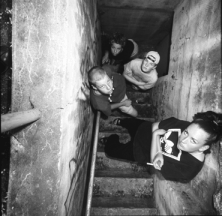

|
What do we do with bad kids? |

|
What do we do when kids are bad -- really, really bad? What do we do when they pillage, rape, and kill? How do we balance holding them accountable with giving them the chance to learn from mistakes -- and at the same time protect society?
Whether the recent changes to the Young Offenders Act are meaningful or merely cosmetic depends entirely on one's interpretation. Although the new strategy is not a radical departure from the YOA, Dr. Bruce Elman, professor of law thinks the shift in emphasis is important.
"[The act] will in fact get tough with violent youth offenders, call them to task, hold them responsible, and give them appropriate penalties." This means more violent young offenders will be tried in adult court and fewer non-violent offenders will be incarcerated.
Dr. James Creechan, professor of sociology at the Centre for Criminological Research is not convinced. He thinks the changes are a merely a public relations exercise. "Legislation doesn't change behavior, social programs do," he says.
The YOA, introduced in 1984, was the result of arduous negotiation. "It [the Young Offenders Act] did exactly what the negotiation process had asked them to do," says Creechan. "It got tougher, it sent kids away for longer periods of time, it put more of them away, it made them more accountable. Twenty-five years of research went into creating the YOA and it is not going to be replaced in six months."
Then why is Anne McLellan, federal justice minister and attorney general, changing it?
Elman believes the government is feeling pushed into making amendments to the YOA: "There is a public perception that crime is increasing, that violent crime engaged by youth is out of control, that the YOA is not working and is indeed inappropriate." Naturally, the government is interested in meeting this public perception. "The truth of the matter is that youth crime is not out of control," says Elman. "The statistics indicate that youth crime has actually declined over the past number of years." Creechan agrees. He thinks MacLellan's major concern is the public perception of the YOA. "The public is just wrong. They have no idea what the YOA does. They have no idea of how effective it has been."
When the act was introduced in 1984, those responsible for promoting and highlighting the benefits didn't do their job, says Creechan. "Public perception was fueled by a really lousy public relations job done by the Department of Justice to sell it [in 1984] and so now they are trying to make up for that," he says.
Nonetheless, the government is charging ahead with a replacement program, called the Youth Criminal Justice Act. 'Putting the public first' is its priority and it will be implemented in three ways.
The first is a strong prevention component linked to school and social programs and the federal Crime Prevention Initiative, the National Children's Agenda, and the Royal Commission on Aboriginal Peoples. A $32 million Crime Prevention Initiative is aimed at developing community-based responses to crime, with a particular emphasis on children and youth.
The second initiative gets tough on crime. More young offenders could be transferred to adult court and become eligible for adult sentences. A new 'patterns of convictions for serious violent offences' category has been added. In addition, youth charged with serious crimes -- murder, attempted murder, manslaughter or aggravated sexual assault may be tried as adults when they're as young as 14 (down from 16). It will be easier to disclose the identity of the youth after conviction and the time between the conviction and sentencing will also be reduced.
The third strategy of the new act includes a full-range of community-based sentencing. "What do they learn in jail?" asks Elman. "They learn how to be better criminals and they become more violent. So it just exacerbates the problem." Police warnings, group counseling, victim-offender mediation, and other diversions to reduce the number of youth in custody make more sense, he says.
The problems with young offenders do not lie completely with a faulty act or the public's perception of the act but also with our social strategy, says Creechan. "At the same time the YOA legislation was admitted, a report was also released indicating a record number of children living in poverty," he says. "Failure of our social safety net is contributing to why children are ending up in court." He feels cuts to assistance programs for children in poverty foster the very breeding ground for delinquency.
"We have loosened the strings of support, then demanded tough laws to deal with the children of people increasingly unable to sustain a family let alone to parent."
Both Elman and Creechan believe the minister and the Department of Justice must convince the public that the current youth justice system works. It just needs some fine-tuning. The long-term solution? Early identification of problems in schools and rehabilitation programs.
"I hope she (McLellan) can garner public support this time and allocate the necessary funds for social services and rehabilitation programs to make it work," says Creechan.

![[Folio]](http://www.ualberta.ca/~publicas/folio/gif/small/folio.gif)
Folio front page |
![[Office of Public Affairs]](http://www.ualberta.ca/~publicas/gif/small/opahome.gif)
Office of Public Affairs |
![[University of Alberta]](http://www.cs.ualberta.ca/gif/uahome.gif)
University of Alberta |